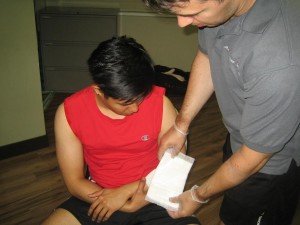Some spiders are dangerous to humans. The two spiders that are highly poisonous include the black widow spider and the brown recluse spider. They both prefer warm climates and dark and dry places where there is plenty of flies, but they sometimes live in dry, littered areas that are undisturbed like closets, piles of wood and under sinks.
Black widow spider bites are not very lethal. It has a red hourglass mark found in its belly and the bites of this spider is like a prick of a pin and the person cannot feel that he/she has been bitten. There is a presence of a slight swelling and a faint red mark in the affected area. Within an hour, intense pain and stiffness will begin and some symptoms such as nausea and vomiting, chills, fever and severe abdominal pain.
The brown recluse spider has a violin-shaped marking found in its back and the bites can cause mild stinging that is followed by redness of the affected area and intense pain within eight hours. A blister will form that is filled with fluid at the affected area, then it will sloughs off leaving a deep, enlarging ulcer. Symptoms of a brown recluse spider bite include a mild fever and a rash. The individual who has been bitten by the spider can experience nausea and listlessness. Oftentimes, death can occur among children.

If bitten by a spider, first identify the type of spider that bit the person. The affected area should be cleaned well with soap and water. Apply cold compress over the affected area. If the affected area is on the extremities, elevate it. Provide Tylenol and antihistamines to relieve signs and symptoms that occur in adults. By enrolling in a first aid course, you can learn how to handle a bite from these spiders.
If bitten by brown recluse or black widow spider, the following must be done:
- Cleanse the wound using soap and water as well as the skin surrounding the affected area.
- If the person was bitten in the arm or leg, place a secure yet comfortable bandage above the affected area and raise the limb in order to slow down or stop the spread of the venom. Do not tie the bandage too tight since it will cut the circulation of the arm and leg.
- Apply a cold compress on the affected area
- If the bite needs an anti-venom medication, seek medical help.
Preventing a spider bite
Black widows are not aggressive and will not usually bite humans unless people will destroy their webs or brush up against them, thus individuals especially children must be familiar and should avoid the black widow spider. This is the best way to prevent a bite. People should be vigilant in dark, secluded areas where there are many spiders such as the garage, attics, closets and piles of wood. People should watch out for spiders when in public or outdoor bathroom facilities, while on picnic or camping since these areas are where people get bitten by these spiders.
